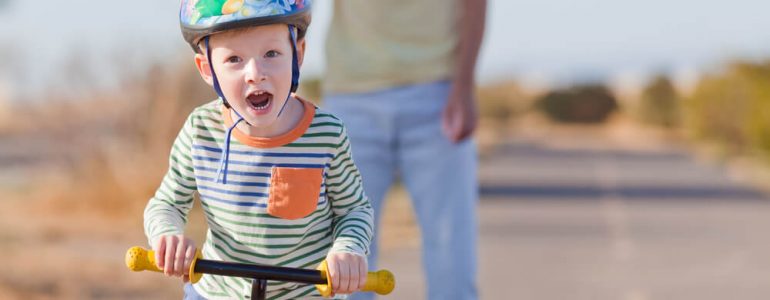Teaching kids to ride a bike might be one of the greatest experiences for every parent. You can see them develop new skills, making their own decisions, and improve the determination.
However, riding can also be challenging for beginners. While you can’t make it easier for them, there are many things you can try to guide your children through the process and have fun.
Choosing the right bike is one of these crucial decisions. As there are so many options available out there, it can be hard to know which model is suitable for them. In this guide, we’ll show some differences between balance bike vs training wheels to help you make a better decision.
What is a balance bike?
A balance bike is basically a bike without pedals. Your kids have to use their feet to push off the ground for moving forward. They often start with sitting on the saddle while walking, then gliding and running with their feet.
Once the children would cruise along with the feet up, they will learn how to keep balance on the bike, thus being ready to pedal.
With this type of bike, your kids will learn how to balance and move first. This will help them coast comfortably and progress to pedalling later on their own, which is much easier than keeping balance.
What are the training wheels?
Training wheels are additional wheels which are mounted parallel to the rear wheels of a classic bicycle, which comes with a chain, pedals, cranks, rear and front brakes. These parts will assist your kids and prevent the bike from leaning until they know how to keep balance on their own.
The differences between balance bike vs training wheels
1. Weight
While balance bikes are often constructed from plastic, wood, or aluminium, training wheels are typically made of heavy steel. Therefore, small children might find it easier to use a balance bike thanks to its lightweight and compact design.
Also, it can be easier for parents to carry the unit back home once their little ones have done with biking. Though heavy materials make them harder to maneuver or pedal, models with training wheels can be more durable and last longer.
2. Pedalling
Though a balance bike doesn’t have pedals, it provides a great opportunity for your kids to develop an essential skill for pedalling: balance keeping. In fact, this is one of the hardest challenges for beginners. Once they have mastered it, pedalling is just a piece of cake as you can see from this short clip:
Training wheels are also a great option for pedalling, but it might take more time for children to learn this skill. The gearing is often too hard, making it quite hard to turn the pedals or move the bike forwards. And when you take off the training wheels, they have to adapt to the new condition without support.
3. Cornering
Most balance bikes have a low centre of gravity and weight which make it easier and more interesting for kids to corner. Training wheels, on the other hand, keep the bicycle upright so that they have to lean to steer. This is obviously harder and requires more effort.
4. Riding terrain
In general, children can ride balance bikes on most terrains, including sloping surfaces without problems. They can go anywhere and develop a sense of adventure since the young ages. However, keep in mind to choose a model with a brake system to ensure a better control and safety on the road.
Bikes with training wheels can also be used in many types of surface. However, these small parts can topple over sideways, making it difficult to ride on inclined slopes or roll over rough terrains.
Final thoughts
In overall, it is easy to conclude that a balance bike can be a better option for kids than training wheels.
While some parents might worry about the safety issues, these are just rare cases. By moving on their own feet, not only do your children learn how to keep balance but also develop their independence and sense of adventure. So if you are looking for a new bicycle for your little ones, do not hesitate to go for a good balance bike.




